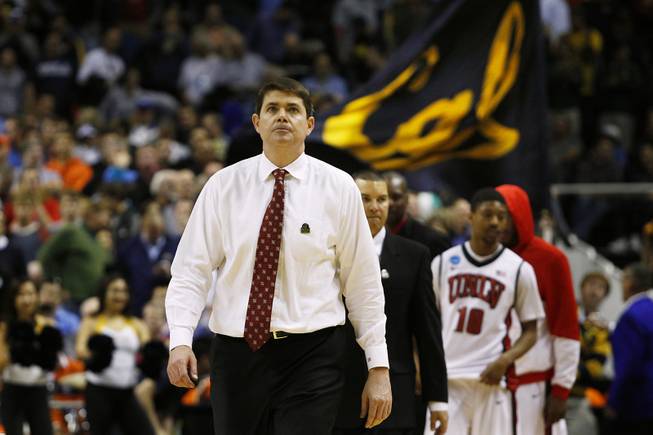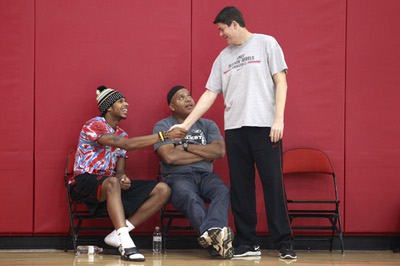
Sam Morris / Las Vegas Sun
As the Cal flag waves in the background, UNLV coach Dave Rice walks off the floor with his team after falling to Cal 64-62 in their NCAA Tournament game in the Round of 64 on Thursday, March 21, 2013, in San Jose, Calif.
Monday, March 25, 2013 | 2 a.m.
Related Coverage
- UNLV Extras: Cal loss will be the takeaway from Rebels’ 2012-13 season
- Run as one and done: Rebels bounced in first tourney game for the fourth straight year
- Bennett the key to Rebels’ bid to finally move on in NCAA Tournament
- Tourney Treats: Stories and trends to watch for in the Syracuse-Montana game
- Tourney Treats: Mountain West officially back in the ESPN family
- Tourney Treats: Special prop bets available for UNLV-Cal game
- Tourney Treats: Upsets in the 12 vs. 5 games a March Madness tradition
- Rebels’ newcomers eager to live their dreams in NCAA Tournament
- Tourney Treats: UNLV-Cal rematch was ‘best we could do,’ committee chair says
- Ray Brewer: Making four straight tournaments is nice for UNLV duo, but there is more to achieve
- Cal’s Crabbe on UNLV matchup: ‘It’s like a home game for us’
- Rebels ready to get down to business in NCAA Tournament rematch
- NCAA Tournament opening lines: UNLV a 2.5-point favorite against Cal
- All UNLV men's basketball coverage
- NCAA Tournament bracket
- All the Sun's NCAA Tournament coverage
Offseason changes, storylines and questions come for every college basketball team. The Rebels just hoped theirs hadn’t come so soon.
After ending the 2012-13 season Thursday with a 64-61 loss to Cal in the Round of 64, UNLV (25-10) must look ahead to 2013-14. And there’s no doubt a fourth straight first-game exit from the NCAA Tournament will add a little extra pressure to UNLV coach Dave Rice and his staff.
Only the last two of those tournament losses are on Rice’s watch, although both of his were as the much higher seed whereas the previous two were in the No. 8 vs. No. 9 game. It’s different because there’s more expected now, and there’s more expected because Rice has made things different. Or at least tried to.
In a way, he’s a victim of his own recruiting success, as the most common refrain after the Rebels walked off the court for the final time was that so much talent was wasted. Fair or not, Rice has to deal with that and plenty of other things this offseason.
Freshman Anthony Bennett is expected to jump to the NBA, and a couple of other Rebels have decisions to make. What’s the team going to look like next year? What needs to change? Who’s coming in?
Let’s start to answer some of those as we take a look forward:
1. A difference in the players
Whenever a coach takes over a new job, he’s at least partly at the mercy of the players the previous coach left behind. Good, bad or otherwise, they’re simply not his guys, so there’s often not the same relationship that would have been established in the recruiting process and there’s no guarantee the players’ strengths will mesh with the coach’s style.
Rice will praise former UNLV coach Lon Kruger and the players who were already here every chance he gets. And the pairing, plus the guys Rice’s staff has started bringing in, has resulted in 51 victories, which is a school record for a coach’s first two seasons.
Still, the difference between taking over a program and running one as your own is getting a roster full of your own players, and Rice is nearly there. The only Kruger guys with eligibility remaining are Carlos Lopez-Sosa and Mike Moser, who committed to Kruger but played only for Rice. And there’s a chance neither one returns next season, though we should know more on that in the coming weeks.
That leaves only Dantley Walker, the high-scoring Lincoln County High guard who committed to Kruger before serving the past two years on an LDS mission. He’s one of five guys joining the team this offseason and the only one who wasn’t recruited to Las Vegas by Rice’s staff.
2. A difference in the style
Two things worth noting in regard to Rice getting his own players into the program: First is that there should be more of the “Runnin’ Rebel Basketball” Rice often refers to, including more full-court pressure and the turnover-driven defense that led to so many points scored in the early '90s.
And second, having (mostly) all his own players puts more pressure on Rice to produce. Not just in the regular season, but come tournament time, too.
Every coach would rather have his own players because he knows what he’s looking for better than anyone else, but it also means there’s one less excuse. Not that Rice or his staff make excuses, but most everyone is aware that accommodations have to be made when you want to play a certain way with guys who have been doing something different.
The quick NCAA Tournament exits, plus some of the ugly performances preceding them, have caused plenty of fans' anger toward Rice. That’s part of the job, and it will only get louder if some of the same problems persist.
3. Zone offense
Speaking of problems, playing against a zone has to be at or near the top of the list. The half-court offense was sporadic all season, with a lot of games against zone defenses featuring almost exclusively passes around the perimeter and isolation play, which is much harder with guys sagging to the middle.
Now, defense is tied into this, as is full-court pressure. If the Rebels are effectively pressuring the ball more often, it will create more run-outs and transition opportunities. And more of those means fewer half-court possessions, and thus fewer possessions against a zone. Both sides of the ball work together, and playing fast could solve a lot of this year’s team’s offensive issues. It could also create different ones, but that’s something to be dealt with when they get there.
This year’s team played good enough defense to do a lot better than it did. UNLV ranked 14th in adjusted defense, according to kenpom.com, and only 114th in adjusted offense. Last year, those rankings were 33rd and 71st, respectively.
The Cal game offered a great example of this. The game was tied when the Rebels went 11:32 without a made field goal, and they trailed by only six when they finally hit a bucket. If the offense were just a little better during that time, this could be a very different story.
4. Who’s playing point?
We’ve addressed the style UNLV would like to play with this staff’s players, but who exactly is going to lead that group? The Rebels aren’t short on candidates, which number as many as five.
First, the returners: freshmen Katin Reinhardt and Daquan Cook. Then there are juco transfers Jelan Kendrick and DeVille Smith, plus incoming freshman Kendall Smith.
At 6-foot-7, Kendrick can play the point or the wing. Kendall Smith is a combo guard and DeVille Smith, who played at Mississippi State and then Southwest Mississippi Community College, is probably the closest of the group to a true point guard, though he can score, too.
Reinhardt said in the locker room after the Cal loss that he plans to work on his ball-handling after averaging 1.9 turnovers per game this year. He was given more time as the point guard later in the year.
Cook’s potential role in this mix will likely depend a lot on his offseason development.
UNLV is going to have options. The key is finding the best one or two so the Rebels have consistency at the position and get what they want from that spot.
5. The recruiting trail
And of course you can’t look to the future in college basketball without talking about recruiting. UNLV’s incoming class isn’t going to have the same top-10 ranking it had last season because there’s no piece like Anthony Bennett in the group, although Kendrick was a McDonald’s All-American two years ago.
Unless there’s a transfer in the coming days or weeks, which is always a possibility, this year’s class is done. The 2014 group, though, could get a jump-start this week as five-star small forward Dwayne Morgan is set to announce his decision Wednesday.
Morgan is down to UNLV, Maryland and Georgetown. He was in town Feb. 9 for the Rebels’ victory against New Mexico.
Recruiting has been the perceived strong suit of this staff from the start, and beating out Maryland for a Baltimore native would only strengthen that reputation.
Taylor Bern can be reached at 948-7844 or [email protected]. Follow Taylor on Twitter at twitter.com/taylorbern.


Join the Discussion:
Check this out for a full explanation of our conversion to the LiveFyre commenting system and instructions on how to sign up for an account.
Full comments policy